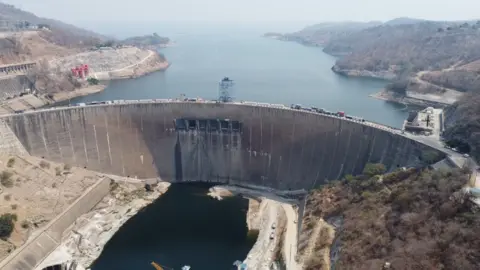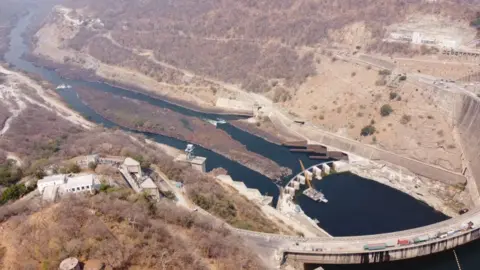Drought strikes at hydro-powered Kariba Dam

 BBC / Kennedy Gondwe
BBC / Kennedy GondweDespite having the mighty Zambezi River and the massive Kariba Hydroelectric Dam, Zambia is currently experiencing one of the worst power outages in living memory.
The problem is so severe that cities and towns across the country sometimes lose electricity for three days in a row, and people count themselves lucky if the lights stay on for an hour or two.
Power outages have shocked 43 percent of Zambians who are connected to electricity and have taken electricity for granted throughout their lives.
But one of the worst droughts in decades – caused by the El Niño climate – has reduced Zambia’s electricity generation capacity.
These days, I go to bars and restaurants and find people who don’t eat or drink – they’re there to charge their phones amidst the blare of generators.
There is also a growing business of people making money by charging the phones of those without power.
Zambia gets up to 84% of its electricity from reservoirs such as lakes and rivers, while only 13% comes from coal.
Contributions from solar oil, diesel and heavy oil are even lower, accounting for 3%.
 EPA
EPAFor several weeks, the problem escalated when the country’s only coal-fired power plant, Maamba Energy, was not operating at a high level as it was undergoing routine maintenance.
On Wednesday, there was good news at last when Energy Minister Makozo Chikote said the plant is now fully operational, and Zambians will have electricity for at least three hours a day.
President Hakainde Hichilema declared the drought a national disaster in February but the government has failed to solve the power crisis because Zambia relies heavily on the Kariba dam for electricity.
The lack of funds has also severely hampered the government’s ability to import power as suppliers demand payment first, although a spokesperson for state-owned electricity company Zesco, Matongo Maumbi, told the BBC’s Focus on Africa podcast that electricity is being bought from Mozambique and South Africa. ease the difficulties, especially in the mining industry – which is Zambia’s leading foreign exchange earner and source of foreign exchange.
Located on the Zambezi, Africa’s fourth longest river, Kariba was built in the 1950s and is the dam of the country’s largest power station, the Kariba North Bank Power Station. Another bank’s power station serves Zimbabwe.
But due to the drought that has resulted in parts of the river drying up, only one of the six wind turbines at Zambia’s power station are operational, resulting in a small production of 7% of the 1,080 MW installed in Kariba.
The dam stores water in the Zambezi with a curved wall that is 128m (420ft) high, 579m (1,900ft) long and 21m (69ft) thick.
Engineer Cephas Museba – who has worked for the state-owned power generation company Zesco for 19 years – says he has never seen water drop like this in Kariba.
 BBC / Kennedy Gondwe
BBC / Kennedy Gondwe“I think we stopped getting rains in February. It should rain until April. If we compare the history of this village, this is the least we have found,” he told me.
It caused an electrical problem that was felt in all businesses and homes.
Some companies open fewer hours, and lay off workers.
Bread may be hard to come by – bakers are making fewer loaves because they find it too expensive to keep generators running.
Fortunately, the government has installed large generators in some markets, government offices and hospitals, although there are still stories on social media about how kidney patients are struggling.
Some patients need to be connected to a dialysis machine for up to three hours a day but the power is restored in about an hour or two, sometimes after midnight.
Sometimes, there is no electricity at all for 72 hours in a row.
On those days, I wear the same clothes as yesterday, except for a washed but wrinkled shirt that hasn’t been worn.
Life has become difficult for everyone.
One day recently, I woke up to a foul smell as blood seeped from the bottom of the refrigerator.
All the meat we had bought was gone and we had to give it to our German Shepherd dog, the happiest member of the household these days.
 BBC / Kennedy Gondwe
BBC / Kennedy GondweOne day I bought some treats at the supermarket – but when I opened the package at the dining table I realized it was extra food for our dog.
My food budget, already tight due to the cost of living crisis, is now even tighter. Buying perishables in bulk at a cheap price is out of the question as they will just rot.
The government has been encouraging households and businesses to switch to solar energy, and has waived the tax on solar energy equipment to make it cheaper to buy.
But some people say solar panels don’t produce enough electricity when there’s little sunlight – and they don’t have the money to install more panels. Many Zambians cannot afford solar panels at all.
Now, many families have turned to cooking and heating water on portable gas stoves – but shops are running out of gas due to high demand.
So out of desperation and because it’s cheap, they buy coal for cooking and heating water – despite its negative impact on the environment and the climate.
The electricity crisis also affects the boreholes that middle-class families have dug in their areas.
With electric boreholes and solar pumps, homes are now also without regular water, making it difficult to even flush the toilet.
In some schools, children are advised to drink five liters of water each day to reduce the sanitation problem – and outbreaks of water-borne diseases such as cholera, who arrived in this country at the beginning of the year.
Many families are now filling buckets – or bathtubs – with water, hoping it will last until the lights come back on, and toilets flush.
All this has left Zambians frustrated and angry. They point out that the blackout highlights the failure of successive governments to plan ahead – something President Hichilema’s administration has now committed to.
Mr Maumbi said Zesco is investing in many sources of energy, including solar power plants, so that dependence on hydroelectric power can reach about 60%.
But Zambia is not only focused on green energy – coal is also there.
In July, the energy regulator approved plans to build only the country’s second coal-fired power plant.
It is the dirtiest fuel of all, producing the most greenhouse gases when burned, but the government feels that to avoid the same problem in the future, it has no choice but to push forward.
You may also be interested in:
 Getty Images/BBC
Getty Images/BBCSource link





